

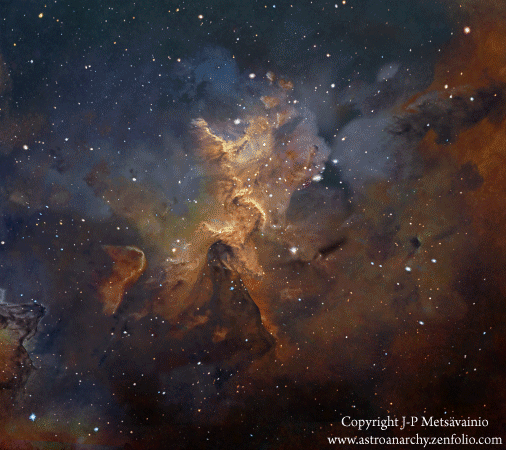
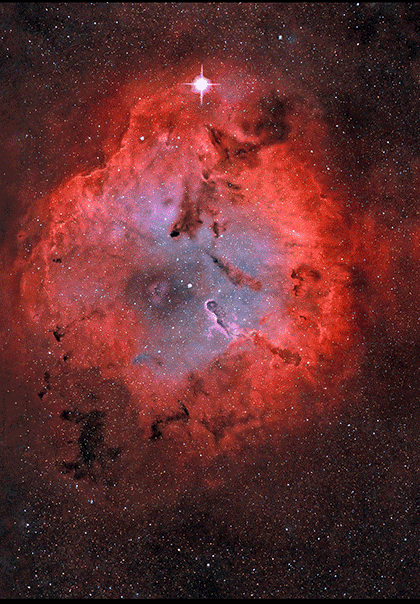
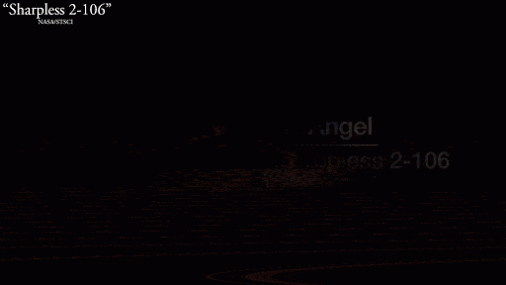
Hubble's Celestial Snow Angel The star forming region known as Sharpless 2-106 is a beautiful nebula
of gas being shot out away from the center area where a new star is being born.
We've released a new video at +Deep Astronomy, where +Tony Darnell beautifully narrates
the science behind the beautiful imagery from +Hubble Space Telescope and Subaru Telescope.
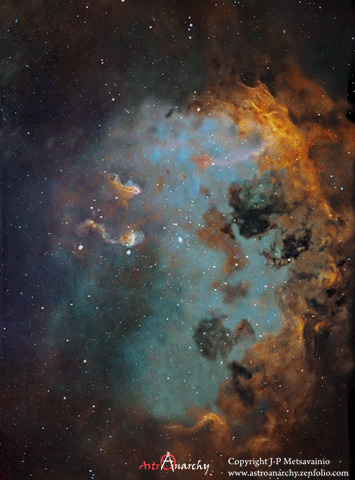
Emission nebula IC 410, in the constellation in the constellation Auriga.
This nebula is about 12,000 light-years away and over 100 light-years across.
It is a cloud of glowing hydrogen gas, whose shape is sculpted by stellar winds and radiation
from an embedded open star cluster called NGC 1893.
Image copyright J-P Metsavainio.

The Pelican Nebula, an H II region associated with the more famous North America Nebula
in the direction of the constellation Cygnus. It is located 1,800 light-years away.
Image copyright J-P Metsavainio
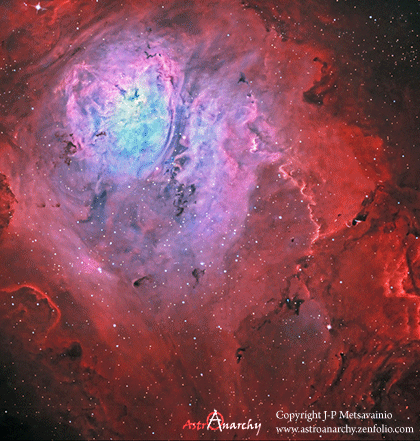
The Lagoon Nebula, estimated to be between 4,000 to 6,000 light years from the Earth,
in the direction of the constellation Sagittarius. It is classified as both an emission nebula and an HII region.
Image copyright J-P Metsavainio.
Globular Nebula NGC6752
NGC 6752, a globular star cluster in the direction of the southern constellation Pavo,
an estimated 13,000 light-years away.
Image copyright J-P Metsavainio.
Helix, NGC 7293
The Latisha Nebula
Images of Supernova - V838 Monocerotis
Rare GIF of a Dying Star Will Make You Rethink Your Existence

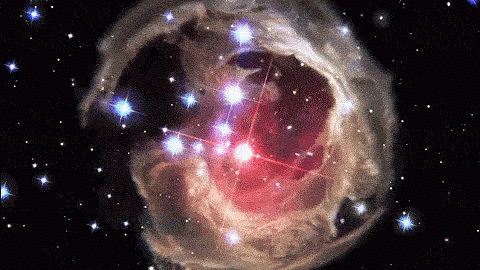
Hubble: Timelapse of V838 Monocerotis (2002-2006)
Uploaded on Oct 26, 2011 The unusual variable star V838 Monocerotis (V838 Mon) continues to puzzle astronomers.
This previously inconspicuous star underwent an outburst early in 2002, during which it temporarily increased in brightness
to become 600,000 times more luminous than our Sun. Light from this sudden eruption is illuminating the interstellar dust surrounding the star,
producing the most spectacular "light echo" in the history of astronomy.
As light from the eruption propagates outward into the dust, it is scattered by the dust and travels to the Earth.
The scattered light has travelled an extra distance in comparison to light that reaches Earth directly from the stellar outburst.
Such a light echo is the optical analogue of the sound echo produced when an Alpine yodel is reflected from the surrounding mountainsides.
The NASA/ESA Hubble Space Telescope has been observing the V838 Mon light echo since 2002.
Each new observation of the light echo reveals a new and unique "thin-section" through the interstellar dust around the star.
This video morphs images of the light echo from the Hubble taken at multiple times between 2002 and 2006.
The numerous whorls and eddies in the interstellar dust are particularly noticeable. Possibly they have been produced by the effects
of magnetic fields in the space between the stars. credit: ESA/Hubble source:
Animated Cartoon of a Nebula
Animated Cartoon of a Black hole eating a star
NASA Releases Stunning Space Photos To Kick Off The ‘International Year Of Light’
Dave Thompson saved to Beautiful Astronomy This galaxy, nicknamed the "Whirlpool," is a spiral galaxy, like our Milky Way, located about 30 million light years from Earth. This composite image combines data collected at X-ray wavelengths by Chandra (purple), ultraviolet by the Galaxy Evolution Explorer (GALEX, blue); visible light by Hubble (green), and infrared by Spitzer (red). (Credit: X-ray: NASA/CXC/SAO; UV: NASA/JPL-Caltech; Optical: NASA/STScI; IR: NASA/JPL-Caltech)
When a massive star exploded in the Large Magellanic Cloud, a satellite galaxy to the Milky Way, it left behind an expanding shell of debris called SNR 0519-69.0. Here, multimillion degree gas is seen in X-rays from Chandra (blue). The outer edge of the explosion (red) and stars in the field of view are seen in visible light from Hubble. (Credit: X-ray: NASA/CXC/Rutgers/J.Hughes; Optical: NASA/STScI)
When X-rays, shown in blue, from Chandra and XMM-Newton are joined in this image with radio data from the Australia Telescope Compact Array (pink) and visible light data from the Digitized Sky Survey (DSS, yellow), a new view of the region emerges. This object, known as MSH 11-62, contains an inner nebula of charged particles that could be an outflow from the dense spinning core left behind when a massive star exploded. (Credit: X-ray: NASA/CXC/SAO/P.Slane et al; Optical: DSS; Radio: CSIRO/ATNF/ATCA)
This galaxy, at a distance of some 700 million light years, contains a giant bubble filled with hot, X-ray emitting gas detected by Chandra (blue). Radio data from the NSF’s Very Large Array (red) reveal “hot spots” about 300,000 light years out from the center of the galaxy where powerful jets emanating from the galaxy’s supermassive black hole end. Visible light data (yellow) from both Hubble and the DSS complete this view. (Credit: X-ray: NASA/CXC/SAO; Optical: NASA/STScI; Radio: NSF/NRAO/AUI/VLA)
This supernova remnant is the remains of an exploded star that may have been witnessed by Chinese astronomers almost 2,000 years ago. Modern telescopes have the advantage of observing this object in light that is completely invisible to the unaided human eye. This image combines X-rays from Chandra (pink and blue) along with visible emission from hydrogen atoms in the rim of the remnant, observed with the 0.9-m Curtis Schmidt telescope at the Cerro Tololo Inter-American Observatory (yellow). (Credit: X-ray: NASA/CXC/MIT/D.Castro et al, Optical: NOAO/AURA/NSF/CTIO)
Animations of the Crab Nebula
Colorful New Portrait Shows Energetic Details Embedded in Supernova Remnant In the summer of the year 1054 AD, Chinese astronomers saw a new "guest star," that appeared six times brighter than Venus. So bright in fact, it could be seen during the daytime for several months. Halfway around the world, Native Americans made pictographs of a crescent moon with the bright star nearby that some think may also have been a record of the supernova. This "guest star" was forgotten about until 700 years later with the advent of telescopes. Astronomers saw a tentacle-like nebula in the place of the vanished star and called it the Crab Nebula. Today we know it as the expanding gaseous remnant from a star that self-detonated as a supernova, briefly shining as brightly as 400 million suns. The explosion took place 6,500 light-years away. If the blast had instead happened 50 light-years away it would have irradiated Earth, wiping out most life forms. In the late 1960s astronomers discovered the crushed heart of the doomed star, an ultra-dense neutron star that is a dynamo of intense magnetic field and radiation energizing the nebula. Astronomers therefore need to study the Crab Nebula across a broad range of electromagnetic radiation, from X-rays to radio waves. This composite picture from five observatories captures the complexity of this tortured-looking supernova remnant. Release ID: STScI-2017-21
Take equal parts 1) supernova, 2) Hubble Space Telescope, and 3) Herschel infrared observatory.
Mix well. What do you get? COLOR="BLUE"> Purple (and pink) majesty.
This video is based on an article I wrote about this observation. And yeah, you want to go take a look;
the high-res picture is pretty phenomenal.
I love this image of the Crab Nebula, if only because the colors are almost electric.
But also because this has been an intensely scrutinized object; people have dedicated their careers to it,
and lots of astronomers have done at least some work on it. I have too; I did a bit of coding for a Hubble observation years ago
As It Turns Out, We Really Are All Starstuff by JASON MAJOR on MARCH 23, 2015
Animation of the Crab Nebula, The driving power here obviously looks like an electric motor.
- starting with the shortest wavelengths (x-rays - blue)
- and progressing through the visible spectrum (green)
- to radio frequencies (beyond infrared).
The sharpless 2-106 Nubulea
Hubble's Celestial Snow Angel The star forming region known as Sharpless 2-106 is a beautiful nebula of gas being shot out away from the center area where a new star is being born. We've released a new video at +Deep Astronomy, where +Tony Darnell beautifully narrates the science behind the beautiful imagery from +Hubble Space Telescope and Subaru Telescope.


